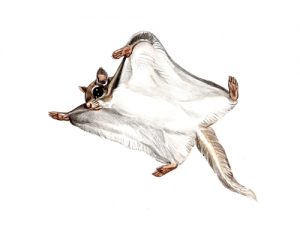How Do Flying Squirrels Fly?
By Chris Williams on November 17, 2011.
Q. I’ve always been confused about this. Do flying squirrels really fly? How far can they fly? I’ve never really seen a flying squirrel but I hear we have them around here.
A. Flying squirrels are not nearly as visible as gray squirrels or red squirrels because they are active at night. People think they’re rare. They’re not; they’re just busy when we’re asleep. And they’re sleeping when we’re out and about. We actually have two types of flying squirrels in our area, the northern flying squirrel and the southern flying squirrel. Flying squirrels are incredibly cute: about hamster-sized with velvety soft fur, big eyes, and bushy whiskers.
Flying squirrels don’t fly in the true sense of the word. Gliding would be a better description of what flying squirrels do. They don’t have wings but they do have a patagium. That’s a big word for a web-like fold of skin that stretches between their front and back legs on both sides. This excess skin is also equipped with cartilage and thin, flat muscles. If you see a flying squirrel sitting on a branch, you have to look sort of closely to see the loose skin on its sides. But when flying squirrels spread-eagle all four legs, all of the excess skin pulled tight between their legs turns them into a square, furry frisbee. A flying squirrel’s rather flattened tail helps with balance when gliding. This ability to “fly” allows the squirrel to escape from predators and greatly extends its food range.
 Since flying squirrels glide rather than fly, they have to start from a high perch. They can’t take off from the ground (in fact, they’re rarely seen on the ground). They leap from their perch, opening their patagium like a parachute. They don’t flap it; the cartilage along the edges and the muscles in the skin hold it open. The squirrel first drops sharply to gain speed, then levels off and glides at a 30 degree angle. At the end of the glide, the flying squirrel drops its hind legs and briefly swoops up before landing vertically on a tree trunk.
Since flying squirrels glide rather than fly, they have to start from a high perch. They can’t take off from the ground (in fact, they’re rarely seen on the ground). They leap from their perch, opening their patagium like a parachute. They don’t flap it; the cartilage along the edges and the muscles in the skin hold it open. The squirrel first drops sharply to gain speed, then levels off and glides at a 30 degree angle. At the end of the glide, the flying squirrel drops its hind legs and briefly swoops up before landing vertically on a tree trunk.
Most glides are from 20 to 60 feet, but glides as long as 240 feet have been recorded! Typically, flying squirrels lose altitude during the flight and have to climb up to glide again. But on short glides of 10 feet or less, they sometimes land higher than they started out. By moving their front legs and shifting their body position, the squirrels can maneuver through trees and can even avoid predators, like owls, while gliding. You can see why it’s impossible to keep flying squirrels off of bird feeders. Anti-squirrel baffles won’t work because these guys attack from above.
Unlike our other squirrels, flying squirrels are social animals that usually nest together. Typical nest sites are in hollow trees or old woodpecker holes. During winter though, they often den together inside attics. Usually a winter den contains an average of six flying squirrels. And when they winter in a nice warm attic, they remain active and noisy throughout the season. If you have flying squirrels nesting in your attic, give Colonial a call. We can humanely remove and relocate the squirrels. And we can seal the openings that the squirrels are using to get into your home.